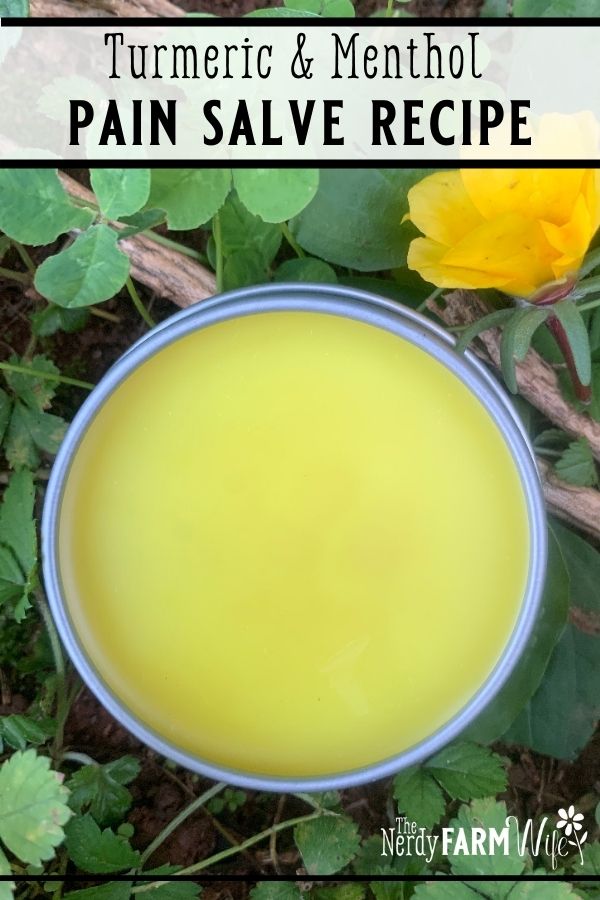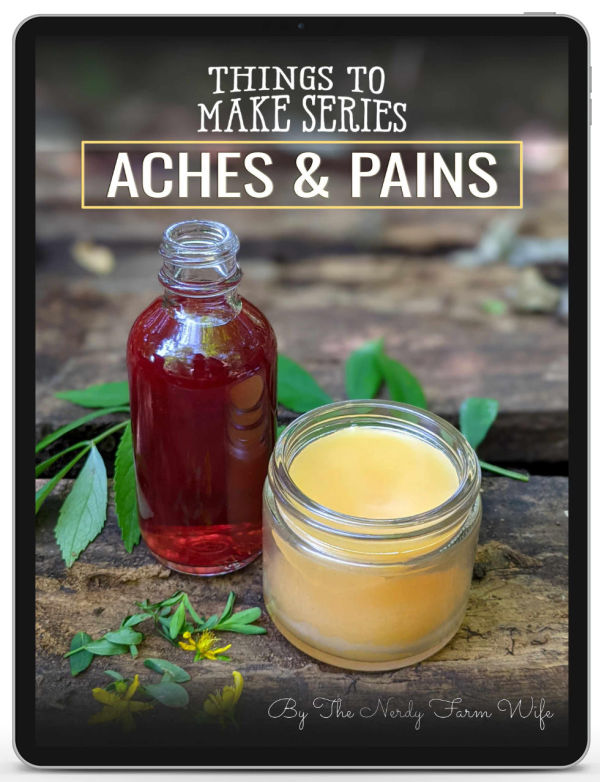Turmeric & Menthol Pain Salve
This salve recipe combines anti-inflammatory turmeric with pain relieving menthol to create an effective salve that can be rubbed into sore or achy joints, backs, feet, or wherever you have pain that’s relieved by a deep cooling sensation.

Today I’m delighted to share a recipe that my daughter created!
For many months, we’ve been working on writing an ebook together about things to make for aches and pains and this is one of our favorite recipes from it.
UPDATE: That ebook, Things to Make for Aches & Pains, is finished!
I really love this salve and use it for the occasional migraine (rubbing on temples, jawline, and neck) and if I sit too long at the computer for a deadline and get leg aches (rubbing it on legs/knees).
She actually first created it for a relative who had plantar fasciitis and it works really well for that purpose too!
Please note that turmeric salves tend to leave a yellow tint on your skin, even with the fairly low amount in this recipe. After you apply it, let it soak in for a while, keeping it away from fabrics and such so it won’t rub off and stain pillowcases, shirts, etc.
With that note, and without further ado, I’ll turn the typing over to my daughter!
Before you can make salve, you’re going to need to infuse an oil!
Plan ahead of time- for a nice, strong oil, you’re going to want to let this one sit for about 2 weeks after heating.
Step 1 – Make Infused Oil
You will need:
- 1 1/2 tbsp dried mullein flowers (or leaf)
- 2 tbsp dried arnica flowers
- 1 tbsp ginger powder
- 1/8 tsp turmeric powder
- 6 oz (170 g) sunflower oil
- 6 oz (170 g) sweet almond oil
- Heat-safe container with a lid (Mason jars are ideal)
- Small saucepan
- Digital scale
Instructions:
Measure out all dried plant matter and powders into a heat-safe container such as a mason jar. Weigh our your oils, and pour them over top of the plant matter.
Place uncovered container into a small saucepan of water over a burner set to low, and leave for an hour or two to kick-start infusing. Stir occasionally, making sure to get all the way to the bottom of the container, as powders will settle.
Remove from heat, and let cool. Once cooled completely, secure the lid on the container, label it with the date and contents, and place in a sunny windowsill for at least 2 weeks to finish infusing.
Shake vigorously at least once daily, makin sure to agitate the settled herb powders at the bottom of the container.
When ready to use, strain the oil through a fine mesh strainer, discarding the spent plant matter. Store the finished, strained oil in a cool, dark location.
Step 2 – Make Salve
Now that you have your oil, it’s time to make the salve!
You will need:
- 0.50 (14 g) oz beeswax
- 3.50 (99 g) oz infused oil
- 3/4 tsp menthol crystals
- 3 drops white camphor essential oil
- Digital scale
- Heat-safe container
- Small saucepan
- Salve tins or containers
Instructions
Weigh out your beeswax and infused oil into your heat-safe container, and place your container in a small saucepan of water over a burner set to medium-low heat to melt together.
Stir occasionally to speed up the melting process, scraping any clinging bits of beewax from the sides of the container. Once completely melted, remove container from saucepan and turn off the heat.
Add the menthol crystals, and drop in the essential oil. Mix until menthol crystals are completely dissolved. Lean your face away for this one! The menthol is strong, and it doesn’t feel good on your eyes!
Once everything’s mixed in, pour your (very, very minty!) salve into salve tins, and leave to set. Once salves are firm and completely cooled, put on their lids, and store somewhere dark and cool- or at least not in direct sunlight!
Ideally try to use up salve within 6 months to a year for best results.



Hi, what could I substitute for dried arnica flowers because I can’t get hold of them where I live?
Hi Caroline! I would swap out something like comfrey root (or leaf), dandelion flowers, or goldenrod (flowering tops).
If those aren’t available, then you could try adding more mullein in their place.
Hi! Instead of just plain almond oil ,can I put lavender infused with almond oil ? I made a good quantity a few weeks ago . Thank you.
P.S. I adore your recipes ☺️
Hi Rodica, Thanks for the kind words – so happy you enjoy the recipes! ? Yes, I think you could definitely use the lavender infused almond oil instead of plain almond oil – it should be a nice touch!
Wouldn’t the scent of the lavender infused oil be totally lost within the heavy scent of the menthol? I would think it would be a waste of the lavender infused oil.
Hi Carol! Lavender infused oil doesn’t often have a strong scent, so the reason to add it here would be to boost the beneficial properties – lavender is very soothing and has some anti-inflammatory benefits. If you have an extra quantity that needs using up, including it in salves or a double oil infusion could be a great way to do so! :)
Just wondering how much this makes, so I know how many tins to have ready…..
Hi Carol! This makes a little over 4 ounces. So you could fill 2 1/2 two-ounce tins/jars, or you could fill 2 two-ounce tins plus a 1 ounce tin. I often pour salves this size into a small 4 ounce canning/jelly jar. It’s about the right size for most batches. :)
Hi, could I substitute St. John more infused oil as I believe it is anti-inflammatory and I don’t have Arnica on hand. Thanks for your great posts.
Hi Lorraine! Yes, I think that sounds like a great addition to the salve. :)
Hello,
I’d like to give this a try! Is there another essential oil I could substitute for the white camphor? I have a fairly large supplies of EOs and would like to hold costs down by not ordering something new. Thanks!
Hi Lucie! You could leave out the white camphor, or eucalyptus might work here too.
The menthol crystals carry a lot of the power in this recipe; the camphor (or eucalyptus) would just give it a little extra punch. :)